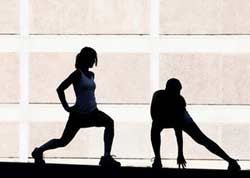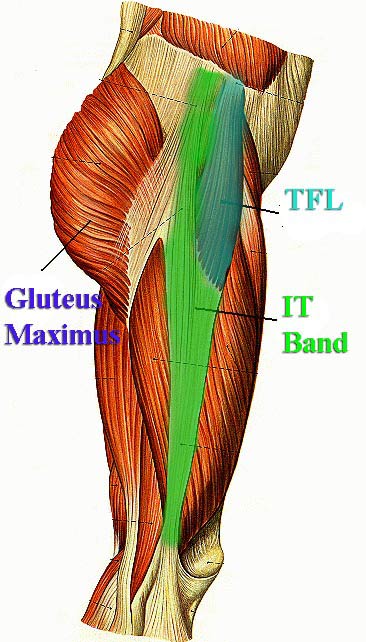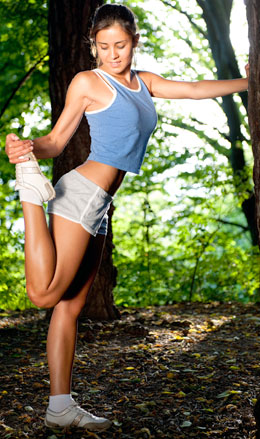- Like
- SHARE
- Digg
- Del
- Tumblr
- VKontakte
- Flattr
- Buffer
- Love This
- Save
- Odnoklassniki
- Meneame
- Blogger
- Amazon
- Yahoo Mail
- Gmail
- AOL
- Newsvine
- HackerNews
- Evernote
- MySpace
- Mail.ru
- Viadeo
- Line
- Comments
- Yummly
- SMS
- Viber
- Telegram
- JOIN
- Skype
- Facebook Messenger
- Kakao
- LiveJournal
- Yammer
- Edgar
- Fintel
- Mix
- Instapaper
- Copy Link
The Importance of Stretching the Lower Body and Core

Leg stretches are best used to prevent muscle imbalances and their associated posture problems. Since tight muscles are common, stretching can be important for many people to prevent posture problems.
In the past, people mainly stretched because they thought it would prevent injury, however, there is conflicting research about this claim. However, I personally believe you can reduce your risk of injury by incorporating a stretching plan into your overall exercise program and so I highly recommend it. In fact, I incorporate a stretching plan into all my clients exercise programs and they have all have achieved great results.
When is the best time to stretch the legs?
All stretches are best performed after a general warm up. A general warm up is a cardiovascular activity which elevates your heart rate. The point of elevating your heart rate for a few minutes is to pump blood to your extremities to warm them up.
At rest, the majority of your blood circulates in the core of your body where your vital organs are. When you start moving your body, the blood will work its way to your extremities in preparation for muscular action. This is the best time to perform all stretching including the following leg stretches.
What are Some Good Leg Stretches?
Dynamic Flexibility
Dynamic Stretches are Great for Loosening Up a Muscle Group Before Activity
Dynamic flexibility is repeated movement through full ranges of motion. Dynamic flexibility leg stretches are great to use before a full body, or legs workout. Dynamic flexibility is also very useful if it is performed in between exercises which work the opposing muscle groups.
Dynamic Supine Leg Swings
Lying supine leg swings are great for helping you stretch out your hamstrings, glutes, lower back, core, and chest.
Supine is the position of lying on your back or palms up.
Start: Lie flat on the floor with your arms out to the side. You can lie on the floor, carpet or exercise mat it is only your preference that counts.
Begin the motion: Keep your palms on the floor. Lift one leg up and swing it out towards the opposite hand.
Tap the floor with your foot and bring your leg back to its original position. You do not need to hold the stretch. Do the same with the opposite leg and alternate for 20-50 repetitions.
The name may be misleading, you are not really swinging your leg violently but moving it through as much range of motion as you can do.
Dynamic Prone Leg Swings
Lying prone leg swings are a great way to loosen up your hip flexors. Since hip flexors are tight in many people it is a good idea to do these often to keep your hip flexors loose.
These dynamic leg stretches are great to use in between abdominal exercises because they will make sure the hip flexors do not do too much work.
Start: Lie on your stomach. Put your arms out to the side with your palms flat on the floor. Some women find it uncomfortable to keep their hands out to the side. If this is uncomfortable you can put your hands out in front of your head.
Begin the motion: Very slowly pick one foot off the floor and swing it over the other leg towards the opposite hand. You hips do not have to remain on the floor for the entire time. Remember you are trying to stretch your hip flexors, not perform a complete torso rotation.
Dynamic Opposite Arm & Leg Raise
The dynamic opposite arm and leg raise should probably be considered a core stretch more than a leg stretch. The most important muscle stretched with opposite arm and leg raises is the hip flexors. These are actually a great exercise to perform in between abdominal exercises.
If you are in the middle of an abdominal workout and your abs or hip flexors are completely burned, flip over and perform a few of these. After you perform a few, go right back into your ab exercises and you should feel renewed and able to perform more reps of abdominal exercises.
Start: Lie flat on your stomach. Have your arms out in front of you and your feet outstretched all the way.
Begin the motion: Keep your core drawn in and raise one hand and the opposite foot as high as you can. You should keep your toe pointing straight down towards the floor. Keep your legs completely straight.
Dynamic Lunge Stretch
The dynamic lunge with torso rotation is a great all purpose warm dynamic movement which will loosen up your entire body. In order for you to get full benefit from this you should follow the form exactly. If you perform this correctly you will dynamically stretch your hip flexors, calves, lower back hamstrings and core.
Start: Stand from a normal position. Make sure you have had a general good general warm up.
Begin the motion: Lunge forward a little further than usual. Take the same arm you lunge forward with and lean forward and place your arm on the floor with your lower arm perpendicular to your foot in the middle of your shoe.
Hold for a split second and lunge your back foot forward. Move both hands forward so they are on the floor on each side of your foot. Bring your back leg forward and place your foot slightly behind your front foot. Both feet should be pointing straight ahead for the duration of these stretches.
Keep your hands flat on the floor for a split seconds and lunge forward and repeat. This stretch is difficult if you are inflexible so you may not be able to complete the full range of motion. Do what you can but try to follow the form exactly.
Corrective Flexibility is Best Accomplished with SMFR and Static Stretching
Here is some corrective flexibility techniques to correct muscle imbalances as mentioned on the very important posture problems page. The specific SMFR and static stretching technique will accompany the affected muscle. To get the most effectiveness out of corrective flexibility it is best to perform a general warm up first such as 5 minutes on an elliptical.
Secondly perform the SMFR on whatever body part you need to stretch out. Once you perform the SMFR on a single muscle, switch to the static stretch immediately after. For example if you perform SMFR on your left calf, immediately perform your static stretch before you SMFR your right calf.
Adductors
Tight adductors can cause problems during functional moments. If you notice your knees moving inwards during squats and lunges you may need to lengthen them.
First perform SMFR on your adductor complex on 1 leg. Then perform the static stretch on the same leg.
SMFR
Start: From the plank position with your forearms and toes the only part of your body touching the floor. Abduct one leg as far as you can out to the side.
Place the foam roller under the inner thigh in the groin area. The foam roller should be perpendicular to your leg for the stretch.
Begin the stretch: Let your inner thigh muscles completely relax on the foam roll. Make sure you leave your leg on the most tender spots for 30 seconds as roll up and down your leg.
Static Stretch
Start: From a standing position spread your legs out to a comfortable distance. Make sure your feet both point straight forward.
Begin the stretch: Shift your weight away from the leg you plan to stretch. Straighten out the leg you are stretching completely and flex the thigh muscles.
This will allow your adductor complex to relax. Hold the stretch for 30-45 seconds.
Variations: You can perform the kneeling adductor static stretch with the non-stretching knee on the floor.
You can also perform static leg stretches for the adductor while you sit on a stability ball.
Piriformis
A tight piriformis muscles is usually evidenced by excess external rotation during functional movements. If you notice your knees moving outwards excessively during a squat you may have a tight piriformis.
Another way to see if you have a tight piriformis is to stand upright with your feet directly under your hips with your feet pointing straight ahead. Stand still for around 30 seconds. If your legs feel uncomfortable like they want to externally rotate you may need to perform these piriformis corrective stretches.
SMFR
Start: Sit on a foam roller which is directly under and parallel with your shoulders. Lift the side you want to roll and put the leg across the opposite.
Bring your hand over to the other side as your rotate your hips so that one side is in contact with the foam roller.
Begin the stretch: Move your butt up and down and slightly to the side until you find a tender spot. Let it sit on the most tender spot for around 30 seconds.
Static Stretch
Start: Lie on your back flat on the floor. Lift the leg you wish to stretch and pull your ankle across your opposite leg.
Begin the Stretch: You want to pull your knee towards your opposite shoulder. It actually works better to pull your whole shin in the direction of you shoulder.
Make sure you don’t rotate your hips and back off of the floor.
Variations: The piriformis stretch is sometimes better as an assisted stretch. A partner who knows what they are doing can push the leg downwards to achieve a more effective stretch.
Calves
Tight gastrocnemius, soleus and peroneals can cause a multitude of problems including plantar fasciitis, heel spurs, knee problems and even shin splints. Tight calves are very common in women who wear high heels as well as anybody with flat feet.
SMFR
Start: Lie on the floor and place your feet out in front of you with your calves on a foam roller. Relax your feet and do not tense up your calves.
Begin the stretch: Put one leg on top of the other.
Slowly move your calf up and down and rotate side to side to get the peroneals.
Variation: If it hurts a lot, you can put both calves on the roller at the same time.
Static Stretch
Start: It is best to take your shoes off. Find a wall or something sturdy to lean against.
Lean forward and put one leg back. Make sure your back toe points straight ahead.
Begin the stretch: Push your back heel all the way down to the floor. Isometrically contract every leg muscle except for your calves. Hold the stretch 30-45 seconds.
Variations: If your calves are pretty flexible to begin with, you may increase the range of motion if you place your toes on an elevated surface such as a weight plate.
IT Band / TFL SMFR
 These leg stretches may sound like a secret code but they are rather simple. The Tensor Fasciae Latae (TFL) and Ilio-Tibial band (IT) are the muscle and thickening of the muscle covering.
These leg stretches may sound like a secret code but they are rather simple. The Tensor Fasciae Latae (TFL) and Ilio-Tibial band (IT) are the muscle and thickening of the muscle covering.
It originates on the side of your leg at the top of the hip and runs all the way to the side of your knee.
These tighten up when your main leg muscles (glutes & quadriceps) are relaxed. When you stand you can feel the side of your leg as evidence it will be very hard.
If chronically tight you are at risk of developing IT band friction syndrome which results in knee pain. IT band syndrome is common in runners and people who stand very often.
A tight TFL / IT band will also decrease your performance during functional activities.
The good news is SMFR is effective at aiding in the prevention and treatment of IT band syndrome.
Since you are dealing mostly with fascia, the Self-MyoFascial Release technique is superior to leg stretches for the TFL and IT band.
SMFR
Start: Lie on the foam roller with the side of your hip on the roll. The only point of floor contact should be your arm. Relax your leg muscles.
Begin the stretch: Slowly roll down towards your knee. Make sure to keep the side of your leg on the roller.
Stop on any tender spots and let it sit for around 30 seconds.
Try to roll the entire side of your leg out and get all the tender spots as you go. The whole process could take 30 minutes.
Variation: If it is too painful to have your entire body weight on the roller, you can put the top leg on the floor in front of you to alleviate some of the pressure.
Beside Corrective Flexibility, Are There Any Other Uses For These Stretches?
The leg stretching exercises on this page are good for many reasons. The most important is to correct muscle imbalances. If you perform these stretches you will keep your muscles healthy which will help your joints in the long run.
Some people think that the SMFR has muscle building applications as well. The foam roll allows better blood flow in muscles. Since lifting weights involves pumping blood into muscles, SMFR should allow you to achieve a better pump.
This is important for some muscles more than others. The calves for example would benefit from a SMFR session before any calf exercises because they are difficult to build and extra blood flow could allow you to build your calves more efficiently.
It is a good idea to experiment and see what works best for you. Remember, always take care of the basics before you try anything “cute.”
Use these Leg Stretches as Part of a Complete Exercise Program
- Exercises to Strengthen your Quads, Hamstrings, and Glutes
Learn the best exercises to strengthen your quads, hamstrings and glutes. - The Complete Resistance Training Guide
Click on any body part on an anatomy chart to find the most basic and best exercises which everybody can use to have a complete exercise program. - Key Upper Body Stretching Exercises
Learn some basic stretches to for your upper body to lengthen your chest and back after a tough weight training workout. - Ask the Trainer Q & A
Have specific questions about muscle imbalances, inflexibility or other question? Check out our Q&A archive for you may just find the answer there.
About Michael Behnken
Mike Behnken is a personal trainer who holds multiple NASM certifications and a MS in Exercise Science. Mike loves fitness, travel, and photography among many other interests.

